By David A. Norris
On the morning of February 14, 1797, the four-decked, 136-gun Santisima Trinidad of Spain’s Armada Real claimed the title of the world’s most powerful warship. Battered by a pack of British ships in a fleet action off Cape St. Vincent, Portugal, the four decks of the Santisima Trinidad by 5 pm were strewn with wrecked cannons and the blood of nearly 500 casualties. After the Spanish ensign came down, the hated Union Jack flew as a symbol of surrender, and the survivors waited for a British prize crew.
The first vessel to draw near through the smoke of battle, though, was another Spanish ship, the 74-gun Infante don Pelayo. Captain Cayetano Valdes of the Pelayo was appalled at the idea of surrendering the greatest ship in his navy. From his quarterdeck, Valdes shouted to his crew, “Muchachos! We save the Trinidad, or we all die!” His men shouted in unison, “Long live the king!” Guns leveled at the splintered hulk that loomed over his smaller vessel, Valdes warned the crew of the Santisima Trinidad that if they surrendered he would treat them as enemies and fire on them. Valdes was determined to prevent a disastrous day for Spain’s navy from growing even gloomier.
The fleets of Great Britain and Spain clashed off of Cape St. Vincent because of the August 19, 1796, Treaty of San Ildefonso, which allied Spain with the revolutionary regime of France. In October, Spain declared war on Great Britain and Portugal. The Netherlands also threw in its lot with the French. With its new allies, France added two major European navies to its own forces and made plans to launch an invasion of Great Britain.
In the wake of the French alliances, Britain abandoned its Mediterranean holdings of Corsica and Elba. A rising star general named Napoleon Bonaparte led French forces deep into Italy. Rebellion simmered in Ireland, sparking fears that French troops might land to support a successful revolt. Great Britain’s economy reeled under the onslaught of bad news. The Bank of England suspended specie payments, and the price of consols (consolidated government bonds, which were the primary financial investments of the time) plunged below the floor they had reached during the American Revolution.
Spain invested considerable effort in its navy during the 18th century. In the 1790s, theirs was the third largest of the European fleets, surpassed only by those of Great Britain and France. Spanish ship design and construction equaled or surpassed that of the British. Fatally compromising its potential advantage in ships, though, Spain failed to sign on enough sailors to adequately man its vessels. Naval training and drill were neglected.
Early in 1797, Spain planned to shift its Mediterranean ships of the line to the Atlantic to join the French fleet. Preventing this move was the duty of Admiral Sir John Jervis. Born in Staffordshire in 1735, the future admiral was the son of a barrister. Although the elder Jervis intended for his son to follow him into the practice of law, young Jervis ran away to sea at the age of 13. He was sent home but soon won out on his wish for a naval career. Knighted for his 1779 capture of the Pegase, a French 74, he left active service several years later and was elected to Parliament. Resigning his seat after war broke out with France, Jervis was soon back in the navy, taking command of the Mediterranean fleet in 1795.
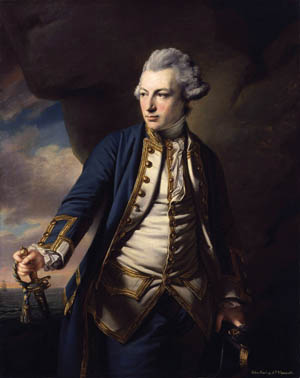
With the British forced out of the Mediterranean, Jervis relied on friendly Portugal for a base while patrolling with his fleet in the Atlantic off Cape St. Vincent. At the southwestern corner of Portugal, the cape was a good point to intercept ships bound to or from Spain’s port of Cadiz. Several major naval battles had been fought off the cape; most recent was a 1780 victory by a British fleet under Sir George Rodney over a smaller Spanish force.
In January 1797, Spain assembled 27 ships of the line at the Mediterranean port of Cartagena. In command was Teniente General Don Jose de Cordoba. (Some senior naval ranks in the Spanish service were similar to army ranks; Cordoba’s rank made him the equivalent of a British vice admiral.)
Cordoba’s flagship was the impressive Santisima Trinidad. Built as a large three-decker at Havana in 1769, the ship went through an ambitious renovation in 1795. Her raised quarterdeck and forecastle were combined by linking them with a new deck, turning the Santisima Trinidad into one of naval history’s few four-decked ships of the line. In her new configuration, she was rated at 136 guns, dwarfing the standard 74s or even the 100-gun ships of the Royal Navy.
On February 1, 1797, Cordoba sailed from Cartagena with 27 ships of the line and several frigates and smaller vessels. Their ultimate destination was Brest, where they would join with the French Navy for operations against Great Britain.
Slowing the Spanish fleet were five armed merchant vessels laden with mercury that had to be escorted past British-held Gibraltar to Cadiz on the Atlantic coast. Mercury was vital to Spain’s economy, which depended heavily on gold and silver from mines in New World colonies. Because mercury dissolved silver and gold, it was used to extract much more precious metal from lower grade ores. Mercury was unavailable in the New World at that time, but Spain’s mines at Almadén were the world’s largest source. Part of the shipment was packed into the ship of the line Santo Domingo. One gallon of mercury weighs about 113 pounds, so many of the Santo Domingo’s 74 guns were removed to accommodate the cargo.
Even with the presence of the Santisima Trinidad and four 112-gun vessels among the ships of the line, Cordoba’s fleet was in poor shape to give battle. A Spanish source later lamented that the fleet needed as many as 4,000 more hands to comfortably manage the vessels and guns. About 1,000 of the crewmen were soldiers with no sea training at all. Most ships had only a small core of several dozen trained seamen among hundreds of inexperienced landsmen. A gloomy pall of pessimism loomed over the crews. Interrogation of Spanish prisoners caught after the battle revealed “it was not an uncommon thing … to hear both misfortune and disgrace predicted,” British Colonel John Drinkwater Bethune wrote in his account of the battle.
For their part, the British were stalked by misfortune during the stormy winter of 1796-1797. Two ships of the line, the Courageux and Bombay Castle, were lost through accidents, and three more were out of action undergoing repair. If Cordoba had confronted Jervis early in February 1797, the British might have faced the two dozen Spanish ships with fewer than 10 of their own. On February 6, Rear Admiral Sir William Parker reported to Jervis with six ships of the line, and the next day Captain Thomas Troubridge arrived with the Culloden, bringing the British force to 15 sail of the line.
Another valuable reinforcement reached Jervis on February 13. It was only a single frigate, the Minerve, but the new arrival bore an already distinguished commander, Commodore Horatio Nelson. Busied for weeks with details of the evacuation of Corsica and Elba, he was at last able to rejoin Jervis and unfurl his pennant on the 74-gun HMS Captain. Commanding Nelson’s flagship was Captain Ralph Miller, a longtime naval veteran who was born in 1762 to a loyalist family in New York.
With any luck, Cordoba might have reached Cadiz a day or two after passing through the Straits of Gibraltar. But luck was not with the Spanish. After they entered the Atlantic, contrary winds blew for several days. To keep the undermanned warships and the mercury-laden transports together, Cordoba had to let them run before the wind for several days. By the time the winds shifted, they were hundreds of miles west of where they wanted to be, and they had to get through the British fleet to reach Cadiz.
In the Atlantic Ocean, a passing American ship bought what seemed like good news to the Spanish. The American captain saw Jervis’ force a few days before and counted only nine ships. It looked like the odds would be stacked three to one in favor of Cordoba if he met the British on the way to Cadiz.
On the night of February 13, fog again settled on the ocean. Winds were light, but they were favorable for getting Cordoba to Cadiz. His fleet’s formation loosened as each ship tried to extract as much advantage as possible from the winds. In the fog, the Spanish ships fired cannon shots to prevent potential collisions. They were to the southwest of the British, who were near enough to hear the firing. The log of the Egmont recorded, “35 past 1, heard the report of four guns quick and 1 slow in the SW, and twice repeated.” Several of Jervis’ other crews heard the signal guns, alerting them that an encounter with the enemy was likely after first light.
Sunrise found the British fleet about 25 miles southwest of Cape St. Vincent. Their ships headed south-southwest, putting out all sail to catch the light winds. Soon, signal flags announced the presence of strange sails in the distance to the southwest. It was the Spanish fleet, sailing from west to east. Nowhere near as neatly arranged as the British, Cordova’s fleet was sprawled in a long straggling line, with a wide gap separating the force into two groups. Mist and fog still lingered, alternately revealing and cloaking the approaching vessels.
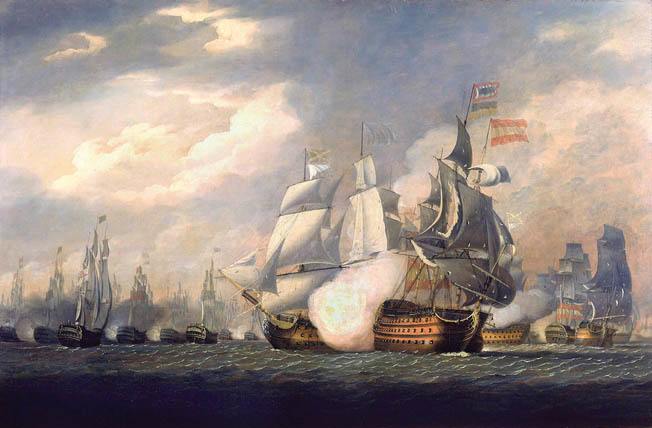
At 8:15 am, Jervis ordered his fleet to form in close order and soon signaled to prepare for action. As the British readied themselves, the Spanish saw glimpses of Jervis’ approaching force through the fog, but they thought those vessels were part of their own fleet. Fifteen minutes earlier, Cordova had detached two 74s, the Infante don Pelayo and the San Pablo, to investigate some other strange sails in the mist to their south.
Don Cayetano Valdes commanded the Pelayo. One of the fleet’s most capable officers, Valdes was also a renowned explorer. In the early 1790s he took part in a Spanish expedition to what is now Vancouver Island, scattering Spanish place names along the coast of British Columbia. Valdes Island, British Columbia, was named for him.
Cordoba’s last news of Jervis, relayed by the American captain, was 10 days old. The Spanish commander still assumed that he would have only nine enemy ships to deal with. When the last of the fog cleared away by 11 am, Cordoba had the unpleasant surprise of learning that Jervis had been reinforced, and 15 British ships of the line were bearing down on him.
At 11 am Jervis signaled his captains to form a single line of battle, and his ships fell into place ahead or astern of the Victory, Jervis’ flagship. This single line would drive like a javelin into the gap between the two sections of the enemy fleet.
The British attack split the enemy fleet, cutting off a smaller group on their leeward (or eastern) side. At first, this handful of vessels numbered six. One of them, though, was seen to “set all sail, and soon disappeared to leeward.”
Three Spanish ships of the larger windward division, the Principe de Asturias, Conde de Regla, and Oriente, were in danger of being cut off by the British line of battle. These three quickly cut across to join the smaller lee division, temporarily bringing their number up to eight. The windward portion of Cordoba’s force set its course northward, roughly parallel with the British but sailing in the opposite direction.
Jervis’ lead ship, Captain Thomas Trou-bridge’s 74-gun Culloden, drew near the windward Spanish ships and opened fire at rather long range at 11:30 am. Each ship behind Troubridge fired in turn as they passed within range.
By 12:08 pm, the Culloden passed the last of the Spanish fleet. Jervis signaled his ships to tack in order to pursue the enemy. Troubridge had already anticipated the order. He sent his answering signal flag aloft, but rolled up. Upon getting the expected order from the admiral, he released the flag to respond instantly. Tacking to follow Troubridge came the Blenheim, Prince George, and Orion.
As the British line turned, the leeward Spanish ships advanced as if they intended to cut through them. Vice Admiral Joaquin Moreno of the Principe de Asturias ordered his gunners to unleash a broadside at the Colossus, the ship behind the Orion.
The Colossus, which had not begun to tack, lost her “fore and fore topsail yards shot away in the slings.” With spars and severed rigging dangling, the Colossus dropped out of line. Five men were wounded in the brief encounter with Moreno. Captain James Saumarez backed the main topsail of the Orion in order to linger and shield the Colossus.
For two hours, the Colossus’ crew cut away the damaged spars and made repairs. The main topsail yard was taken down and put in place of the fore yard; the main topsail became the foresail, and the fore topgallant sail became the fore topsail. By mid-afternoon, the injured Colossus was patched up enough to make headway, but her crew could do no more than watch the battle.
Next in line behind the Orion, the Irresistible exchanged fire with the Spanish before following the path led by the Culloden. After the Orion came the Victory. The Victory hurled a broadside at a Spanish three-decker, leaving the stunned enemy vessel behind. Behind the flagship, the Egmont and the Goliath drove off attackers and continued to follow the ships ahead of them.
Aboard the Goliath, seaman John Nichol spent the battle in darkness deep inside the hull. He recalled that he was “stationed in the after magazine, serving powder through the screen, and could see nothing; but I could feel every shot that struck the Goliath; and the cries and groans of the wounded were most distressing, as there was only the thickness of the blankets of the screen between men and them.”
At least a handful of women and children were also aboard the British ships. Ann Hopping (later known as Nancy Perriam, after a subsequent marriage) sailed on the Orion. Her husband and brother were also in the crew. She was mending a shirt for Captain James Saumarez when the guns opened fire. Putting aside her sewing, she pitched in as a powder monkey during the battle and later helped the surgeons tend the wounded.
Winds remained light during the battle. The log of the Britannia mentioned that she had set her studdingsails. At 1 pm, one of the lower studdingsails was ignited by a cartridge that caught fire on the main deck. The burning sail was cut away to drop overboard before the fire spread.
Their attempted attack blunted, the Spanish lee division was left behind except for the 74-gun Oriente. Screened by the lingering gunpowder smoke, the Oriente slipped away to rejoin the main Spanish contingent.
After passing the last ships of the line, the Oriente came within range of Jervis’ frigates. Normally in major battles, frigates refrained from firing on ships of the line, and the larger ships traditionally ignored smaller enemy vessels. Aboard the 32-gun Lively, a veteran gunner begged the captain to let him take a shot at the Oriente. After continued pleading, the captain let the gunner fire his favorite 18-pounder. Soaring across the water, the ball plunged into the Oriente “near the fourth or fifth porthole abaft.” Later, the Lively’s crew learned that the shot caused several casualties.
Other British frigates, and even the little 18-gun sloop of war Bonne Citoyenne, also shot at the passing Spanish 74. Provoked by the impertinent “small fry,” the Oriente answered with a broadside. But a witness aboard the Lively noted that “so badly were the guns pointed, that not one shot struck our ships, though many went through their sails.” Despite poor gunnery, the Oriente did get back to the main section of the Spanish fleet.
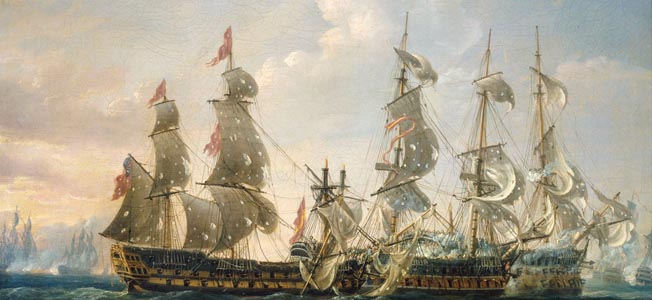
By 1 pm the Excellent, the last ship in the British line, passed the rear of the windward division. At this point, Cordoba’s leading ships steered to starboard, putting them on course to pass the rear of Jervis’ line and reunite themselves with the lee division. If the British tacked one at a time in their current alignment, the Spanish would draw far ahead of them. In the main, the Spanish ships were faster and they would either escape or draw the British into a time-consuming and inconclusive running battle.
It was at this point that Horatio Nelson made a fateful step into naval history. Jervis had sent a signal at 12:51 pm, ordering his ships “to take suitable stations for mutual support, and engage the enemy, as coming up in succession.” Nelson took considerable latitude in responding to this signal. At Nelson’s order the Captain steered to port and continued circling around to pass between the Diadem and the Excellent. Nelson sailed across the bows of several ships toward the rear of the enemy formation and confronted the Santisima Trinidad. As if attacking the world’s most powerful warship was not enough, Nelson also faced four more opponents: the 112-gun three-deckers San Jose and Salvador del Mundo and a pair of two-deckers, the 80-gun San Nicolas and the San Isidro, a 74. Together, these vessels mounted more than 500 guns.
Leading the procession of British ships, the Culloden drew near enough to the Spanish vessels to open fire. Nelson later wrote that the Captain and the Culloden alone engaged five Spanish ships for the space of one hour; help arrived before that long an interval, although it’s likely that smoke and commotion hid other British ships from view.
Troubridge and Nelson were in a perilous situation but were aided by the poor morale and low level of training among the Spanish crews. British officers later observed that several guns aboard a Spanish vessel taken that day were still plugged with tompions. They had not been fired once during the battle. “It was impossible, after the first broadside, for the captain or officers to persuade any of the crew to go aloft and repair the injured rigging,” a Spanish officer is reported as having said in Bethune’s account.
Officers resorted to shooting several sailors, but still the men would not comply with the orders.
Also hurting the Spanish defense was the arrangement of their ships. Instead of an orderly line of battle, they were in a loose formation with some ships sailing two or three abreast. All of the Spanish ships were in some degree exposed to British fire, but some of them could not return fire without hitting one of their own vessels.
Nelson and Collingwood first confronted the Salvador del Mundo and the San Isidro, shooting down some of their topmasts and rigging. Then the Blenheim and the Prince George stepped in with their fire as the Captain and the Culloden moved on against other vessels. Next, the Excellent, under Captain Cuthbert Collingwood, first engaged the Salvador del Mundo before moving on to attack the San Isidro. The latter ship struck her colors at 2:53 pm.
The Irresistible and the Diadem attacked the Salvador del Mundo. Under the continual pounding more than 40 men were killed, including her commander, and her topmasts were gone. When the Victory neared, guns ready to rake her stern, the Salvador del Mundo surrendered.
Collingwood hurried on to aid Nelson in such haste that he left the captured San Isidro behind. Nelson wrote that at this point, his ship had “lost her fore-topmast,” and there was “not a sail, shroud, or rope standing, and the wheel shot away.” Yet, in this perilous state, the Captain was hotly engaged at the range of a pistol shot with the 80-gun San Nicolas. With their carronade ammunition consumed, Nelson’s gunners packed the big short-range guns with loads made of seven rounds of 9-pounder shot.
Up to that point, the sails and rigging of the Excellent were nearly untouched by Spanish fire, and the ship responded with ease to the helm. Collingwood glided in between the two ships, shielding the Captain. At a distance of 10 feet, the Excellent sent a point-blank broadside into the starboard side of the San Nicolas. Trying to avoid this new antagonist, the San Nicolas collided with the 112-gun San Jose.
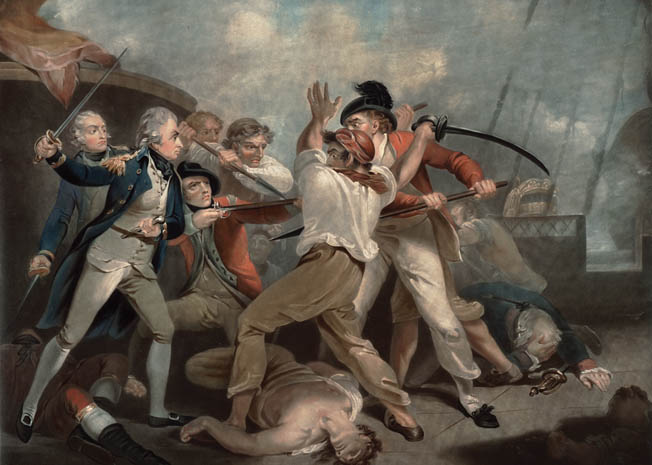
After dealing a heavy blow to the San Nicolas, Collingwood pressed on to deal with other enemy vessels. Nelson realized that his flagship “was incapable of further service in the Line or in chase,” so the commodore ordered Miller to take the ship alongside the enemy and called for boarders.
Miller’s port bow edged alongside the starboard poop deck of the Spanish ship. As the ships loomed closer, a Spanish marine grenadier named Martin Alvarez and his comrades peppered the Captain with musket fire. The vessels came so close that the British ship’s spritsail yard loomed over the enemy’s quarterdeck and ensnared itself in the mizzen shrouds of the Spanish vessel.
On the deck of the flagship, Captain Edward Berry up until this moment had been at loose ends. His service as a lieutenant with Nelson had won him recommendation for promotion to post captain. So far no ship was available for him, so he was aboard the Captain as a volunteer. Berry sprang from Nelson’s deck onto the mizzen chains of the San Nicolas.
Climbing the bowsprit and then balancing themselves on the spritsail yard, Nelson himself led a boarding party over the side and onto the enemy decks. With the commodore came a party of marines augmented by a detachment of soldiers from the 69th Regiment of Foot, which had been assigned to sea duty. Private Stephens of the 69th shattered a window on the upper quarter gallery and leapt into the cabin, followed by Nelson and others.
Locked doors temporarily trapped Nelson’s men in the cabin, but they could see from the cabin windows out onto the deck. Through the glass, they saw Spanish officers firing their pistols at them, their bullets breaking the windows.
As British sailors, soldiers, and marines poured onto his ship, Martin Alvarez threw down his musket in favor of a cutlass. Alvarez ran his blade through a marine officer (evidently Major William Norris of the Captain’s marine detachment) so violently that the point of the sword was stuck fast in a wooden bulkhead. Struggling in vain to loosen his sword, Alvarez was surrounded by British attackers. He was wounded in the head before jumping down onto the main deck to continue the battle.
Nelson’s boarders broke open the cabin doors. Rushing out onto the deck, the commodore’s men found “Captain Berry in possession of the poop.” Brigadier Tomas Geraldino, the ship’s commander, was fatally shot by the boarders. Quickly, the melee on the deck ended with the surrender of the San Nicolas. Another man of the 69th, Private John Ashcroft, took down the Spanish flag to raise the Union Jack over the prize. (Ashcroft’s regiment later boasted “Cape St. Vincent” as a battle honor on its flag.) Nelson made his way to the forecastle, where the ship’s officers surrendered their swords.
Alvarez was found unconscious from the loss of blood near the body of Brigadier Geraldino. Under the care of his captors, Alvarez eventually recovered from his wounds. He was released and returned to the service until his accidental death in 1801.
As Nelson took possession of the prize, the San Jose drifted close, lodging her starboard stern against the port bow of the San Nicolas and entangling their rigging. The raised poop of the 112-gun San Jose towered over the pair of smaller two-deckers. From the high platform of the admiral’s stern gallery and the quarterdeck, Spanish sailors and marines opened fire at the decks of the captured ship.
With a shout of “Westminster Abbey, or victory!” Nelson gathered another force and rushed aboard the San Jose. As Berry helped Nelson onto the enemy’s main chains, an unarmed Spanish officer hailed them from the rail of the quarterdeck, surrendering the ship. By that point, the San Jose had lost 46 men dead and 96 wounded. The ship’s commander, Jefe de Escuadra [Commodore] Don Francisco Javier Winthuysen, had been fatally wounded a few minutes into the action.
So many Spanish officers surrendered their swords that Nelson would have been overburdened with them had he not handed them over to William Fearney, the coxswain of his barge. Fearney followed Nelson, carrying the growing bundle of surrendered swords as if it were an armload of kindling. A witty quip quickly circulated around the fleet, implying the captured San Nicolas was “Nelson’s Patent Bridge for Boarding First Rates.”
During the day, several of Jervis’ ships piled on to attack Cordoba’s flagship. Despite her intimidating appearance and massive array of guns, the Santisima Trinidad was too slow and clumsy to make a practical war vessel. On this day, the famous four-decker suffered 480 men killed or wounded as Jervis’ ships shot away her mizzenmast and main topmast. At about 4:30 pm, Cordoba’s flagship surrendered. The Egmont reported seeing the flagship flying a white flag; the Orion and some Spanish sources saw a Union Jack hoisted aloft.
Despite the intent to surrender, no British ships were available to take formal possession. For some time, the Santisima Trinidad drifted alone on the water. To the great relief of Cordoba, the first ship to approach the battered flagship was Spanish. It was Captain Valdes, returned to the fleet with Infante de Pelayo. Accompanied by the San Pablo, Valdes spent the morning in pursuit of two ships seen south of the Spanish fleet. Late in the morning, Valdes heard heavy firing and turned to follow the sound of the guns. It was late in the afternoon when Valdes reached the Santisima Trinidad and cancelled the flagship’s surrender. Soon other Spanish ships arrived on the scene. Jury rigged and under tow, the 136-gun giant was hauled away to safety.
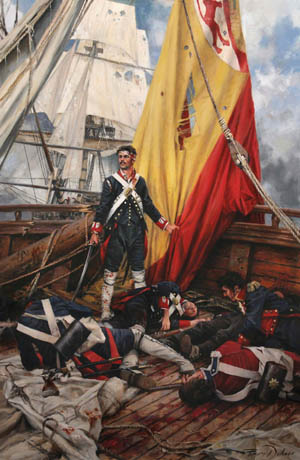
Nelson’s Captain was unmanageable, but the commodore himself was still eager for action. He intended to shift his pennant to one of the less damaged ships of the line, but before he could re-enter the fight the battle faded away. Jervis could have chosen to press his advantage and continue the battle. But, the small leeward division of Spanish ships was nearing the main fleet and posed a threat to the rear of the British formation. The Captain and the Colossus were unserviceable. A majority of his other vessels suffered from battle damage, and some of them already needed repairs because of collisions or storms. Indifferently crewed and commanded or not, a reunited Spanish fleet would still outnumber the British, and several of the enemy ships that took no part in the battle were completely undamaged. Jervis decided to let Cordoba go and to concentrate on securing his prizes and repairing his vessels.
Four ships of the line fell to the British: the San Jose, the Salvador del Mundo, the San Nicolas, and the San Isidro. Each was taken into the Royal Navy. Renamed the San Josef and dubbed by sailors as the “Holy Joe,” the San Jose lasted until she was broken up in 1849.
Spanish casualty estimates ran to about 430 dead, 850 wounded, and 3,000 captured. In the Gazette, Jervis reported 261 dead and 342 wounded among the four captured ships. Numerous officers were among the dead, including four captains of ships of the line, and two commodores. So poorly stocked with medical supplies were the Spanish that some of the wounded were bandaged with cloth taken from cannon cartridges.
The butcher’s bill came to exactly 300 for the British. There were 73 dead and 227 reported wounded, although the latter figure excludes a number of lightly wounded sailors.
News of the victory brought great joy to England. It was encouraging enough that Jervis’ outnumbered fleet won a major battle. But now, although French success on land remained a paramount concern, the battle of February 14 showed that Spain’s large navy was so poorly managed that it posed no great threat to British maritime power.
In Spain, Cordoba and a number of his senior officers were arrested and court-martialed. The commander of the fleet was stripped of his rank, forbidden to appear at court, and exiled from Madrid and its vicinity. In sharp contrast with its harsh condemnation of the aristocratic officers, the court made a very unusual statement of praise for an enlisted man of humble origins, the marine grenadier Martin Alvarez. He earned an honored place in Spain’s maritime history, and two ships of the Spanish Navy have been named for him.
Lavish praise, admiration, and great rewards went to Jervis and his senior officers. In 1801, Jervis was elevated to the peerage and named the 1st Earl St. of Vincent. Two of Jervis’ admirals were made baronets. Nelson turned down the same offer because a baronetcy was beyond his financial means, but he accepted a knighthood as he entered the most brilliant stage of his career.
Just barely, the gigantic Santisima Trinidad escaped becoming a trophy of the Royal Navy after the battle of Cape St. Vincent was over. Unsuccessfully stalked by several British frigates while hobbling to refuge at Cadiz, the flagship came under attack from the 32-gun HMS Terpsichore. After losing several men, the four-decker fended off the Terpsichore and made it to safety.
Fate would bring Nelson and the Santisima Trinidad together again. As a vice admiral, Horatio Nelson commanded the British forces facing a combined French-Spanish fleet at the October 21, 1805, Battle of Trafalgar. Nelson’s plans led to a British victory, even though the admiral was fatally wounded by a French musket ball early in the action. Again harried and battered by enemy ships, the Santisima Trinidad again struck its colors later in the day. This time the legendary flagship became a prize of the Royal Navy. But the British were not able to take their coveted trophy to port. Fatally damaged during the battle, the world’s largest ship of the line sank one day after her capture.
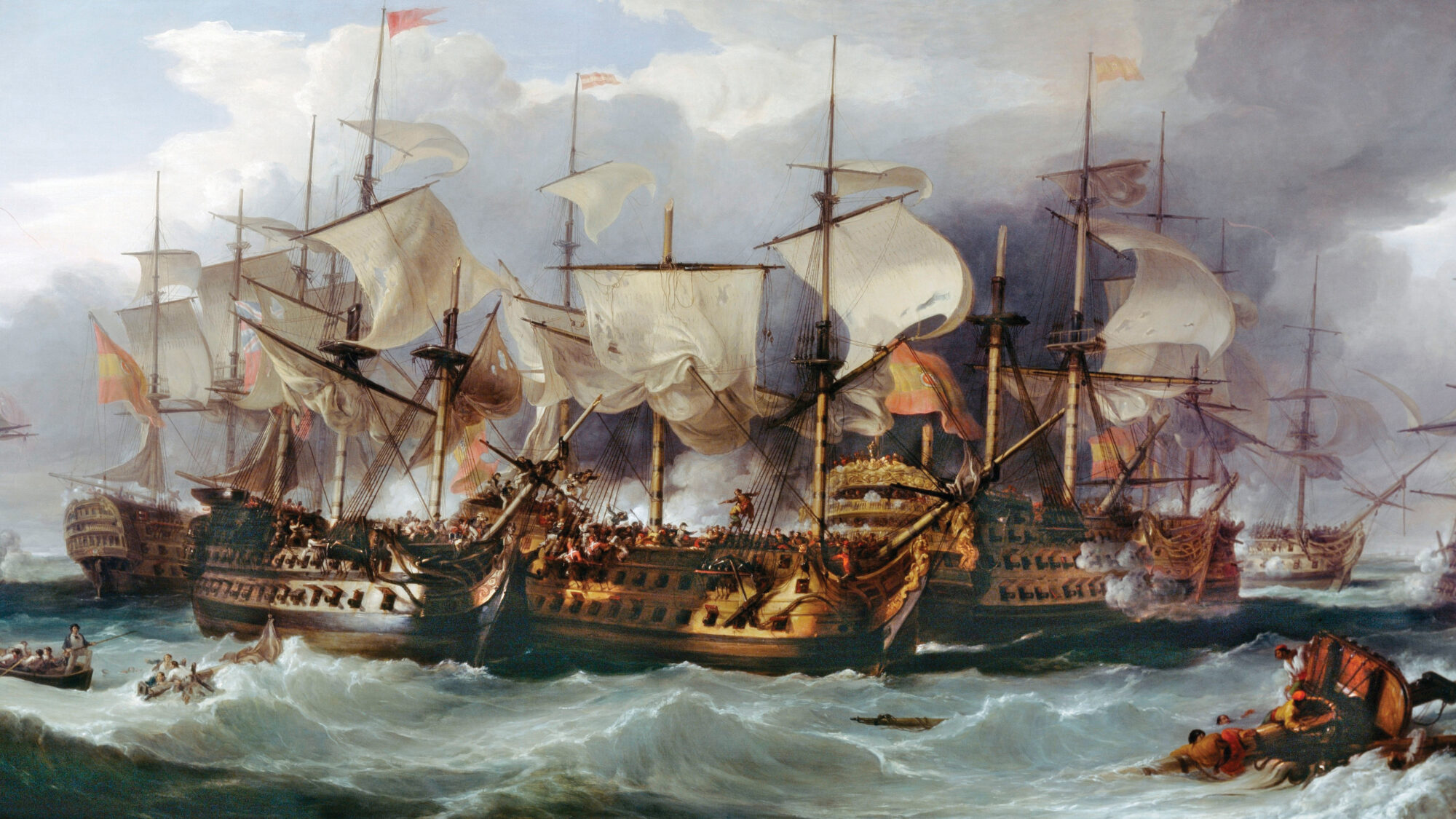
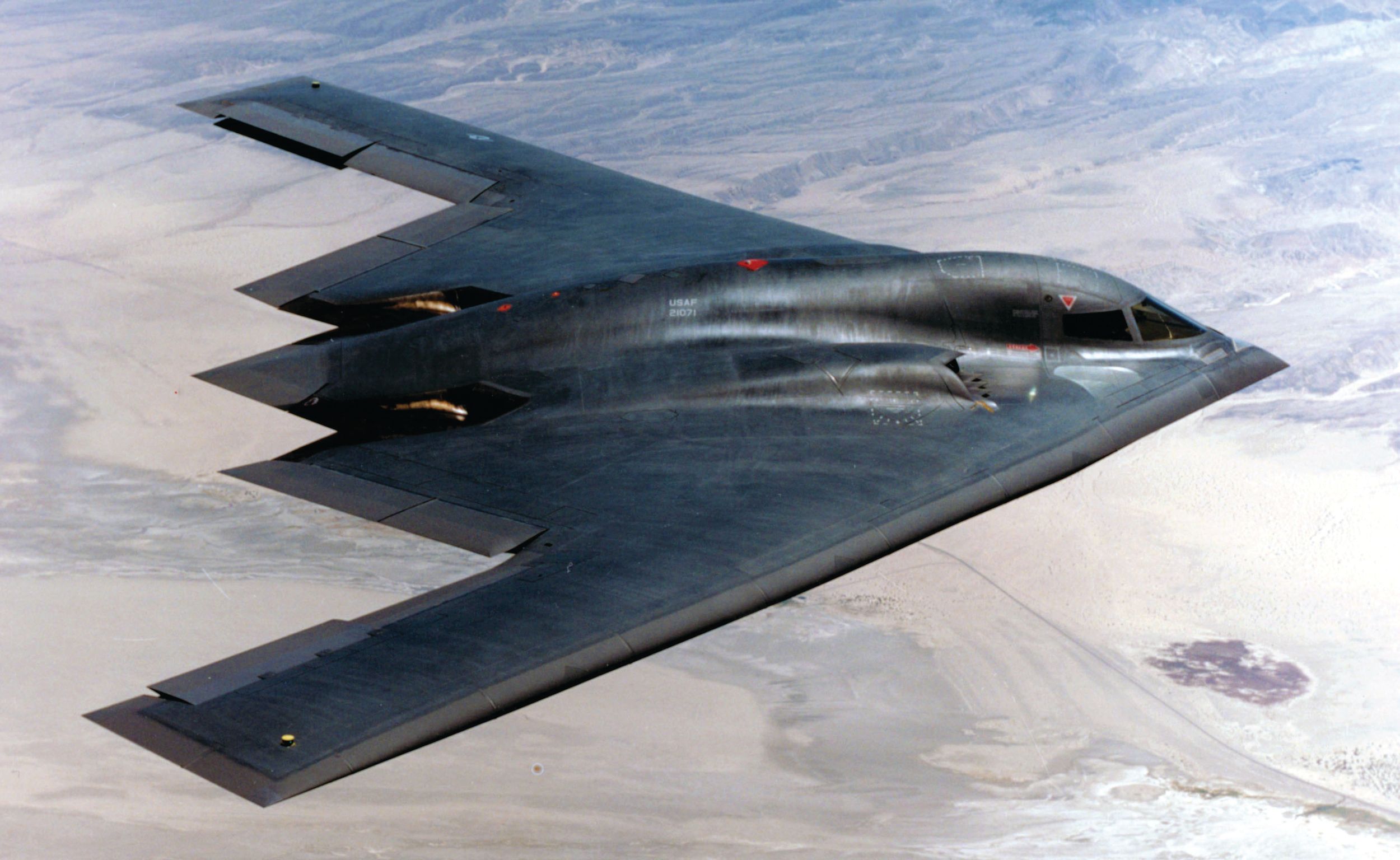
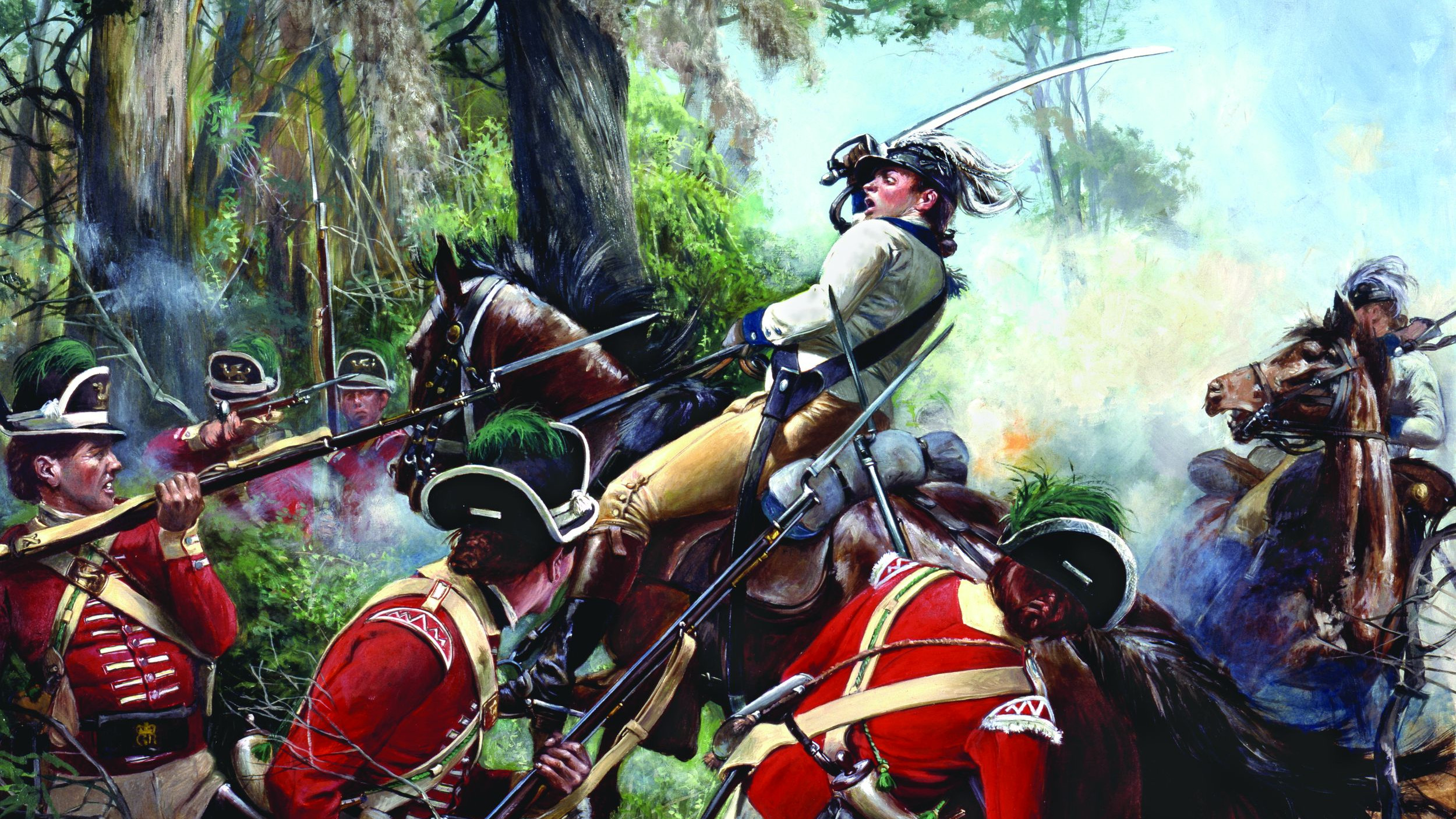

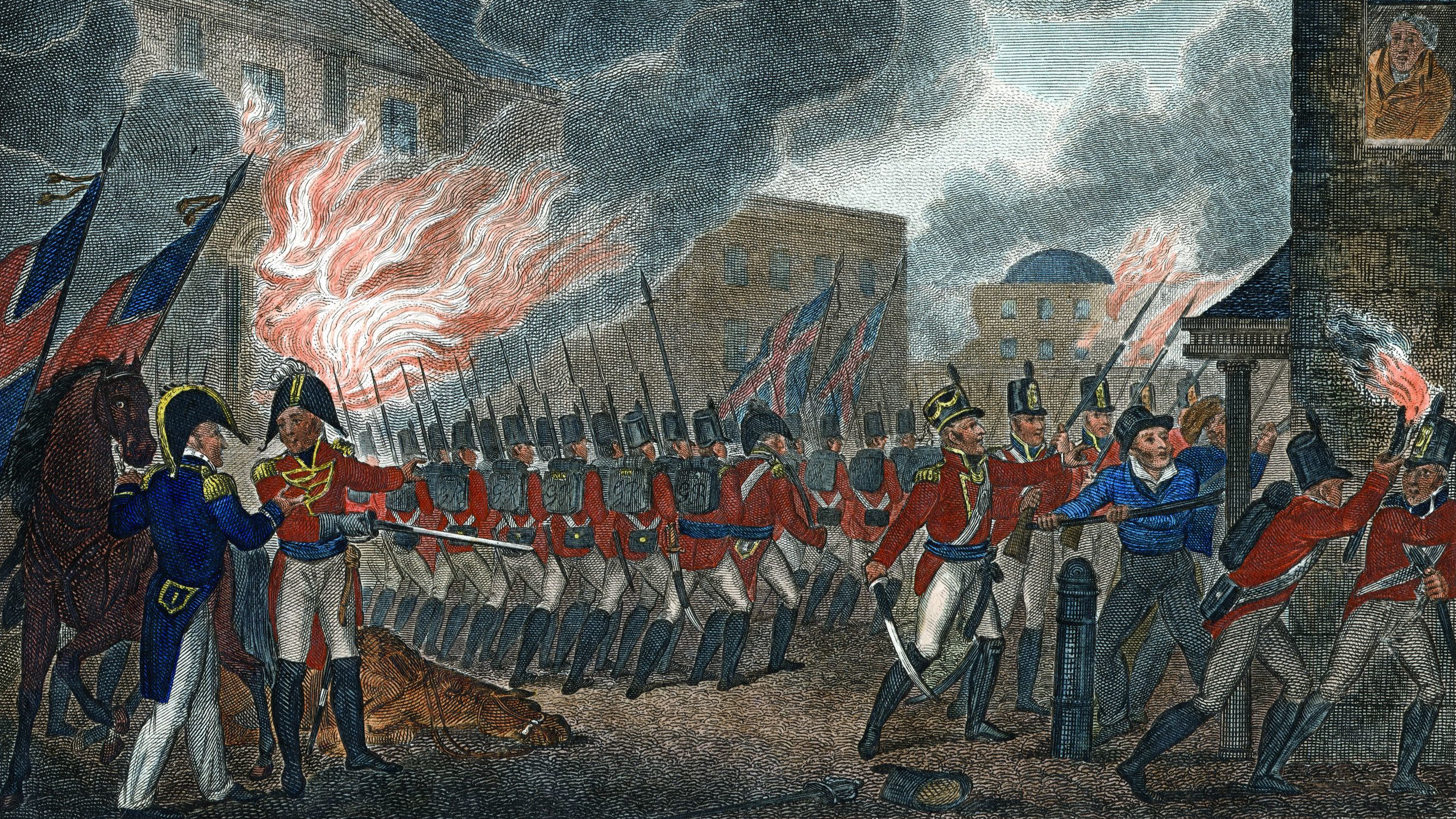
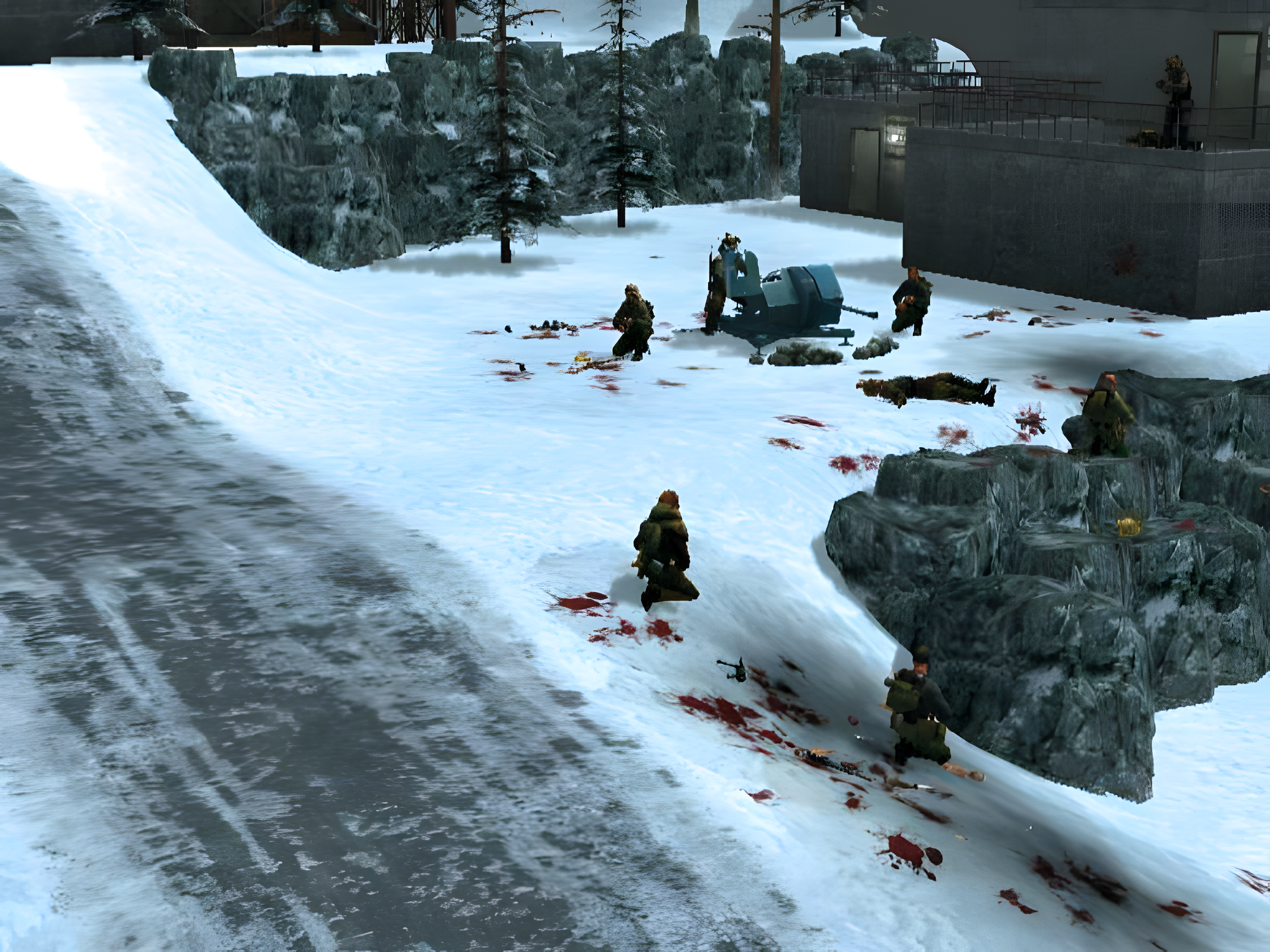
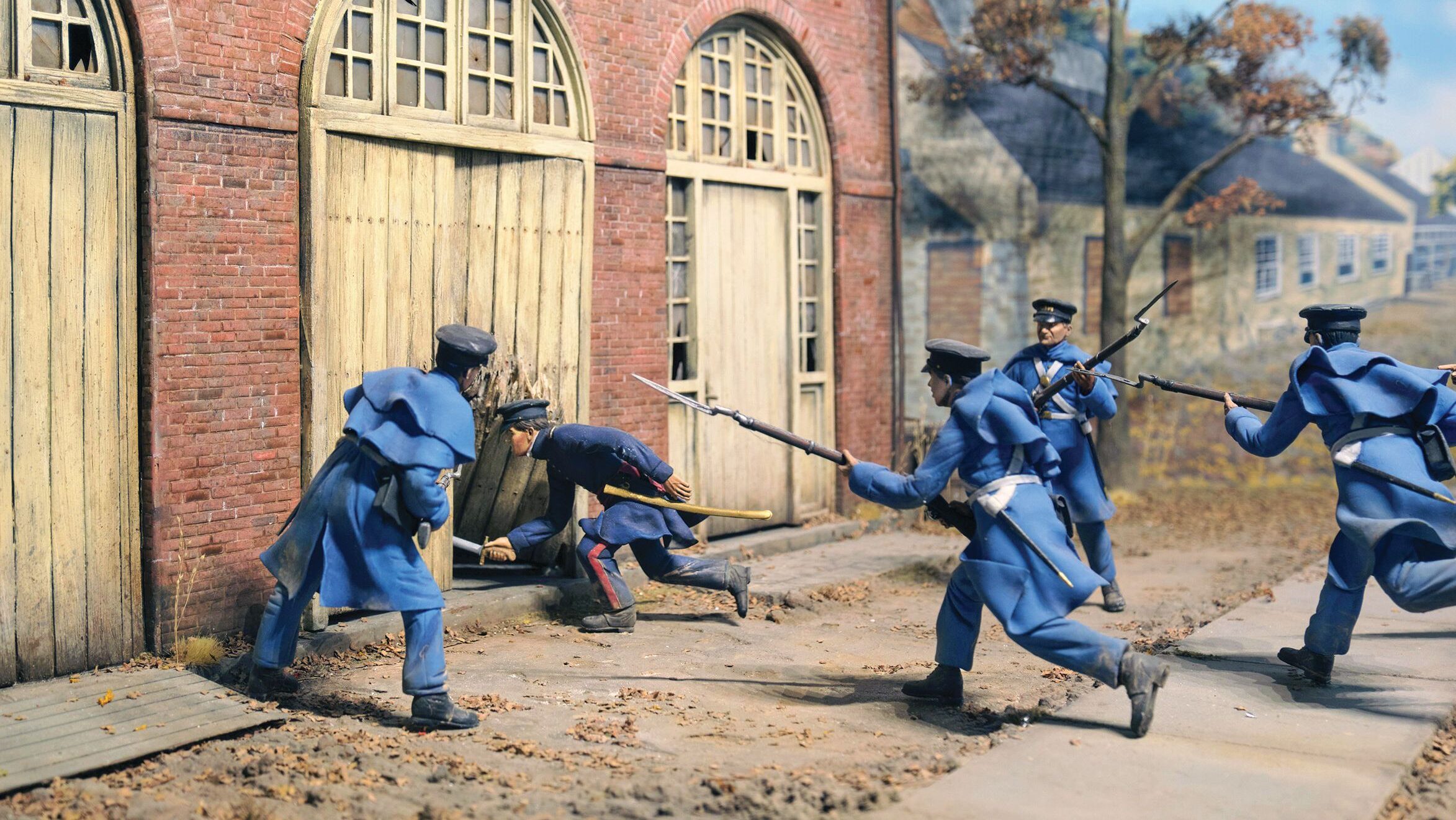
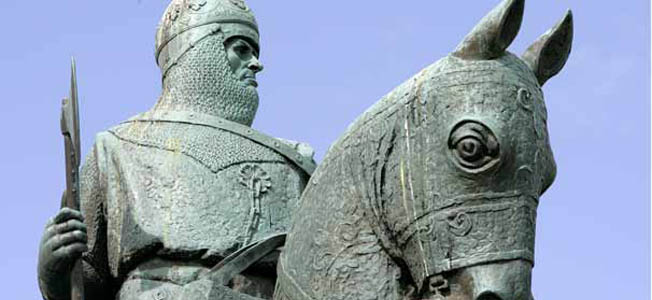
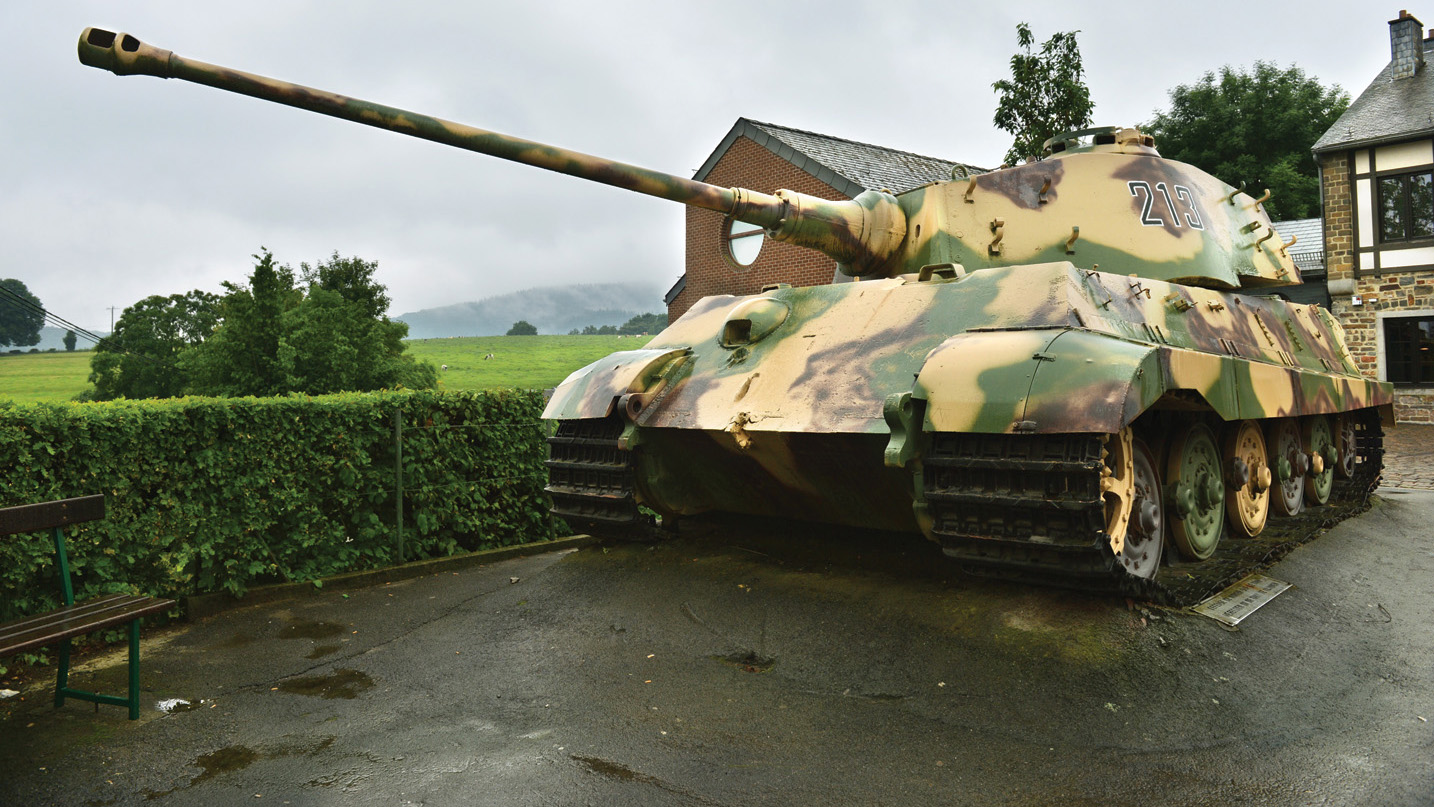
Join The Conversation
Comments
View All Comments